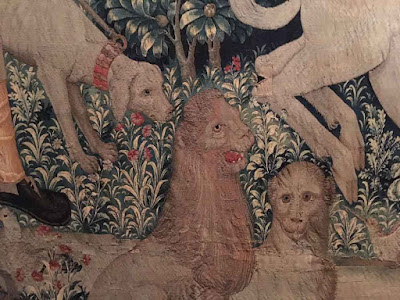We saw the famous unicorn tapestries at the Cloisters, the Met's collection of medieval art. I could have spent all afternoon marveling at the fine scale of the weaving and studying the details of the foliage, the faces and the animals in these tapestries. They are justly famous, and the colors still so vivid, considering these were made 500 years ago. (Who says textiles don't last?) The symbolism of the unicorn and the meaning of the series as a whole are still debated endlessly. At least for me, that mystery is part of the spell they cast. We see an enchanted world we don't quite understand.
 |
| The Unicorn in Captivity, wool, silk and silver and gilded-silver wrapped thread South Netherlandish, c. 1495-1505 |
 |
| detail, The Unicorn in Captivity |
 |
| detail, The Unicorn Purifies Water, wool, silk and silver and gilded-silver wrapped thread South Netherlandish, c. 1495-1505 |
When you look at that much art in a few days, synchronicities are bound to occur. That evening we went to the Museum of Modern Art (MoMA) to see the show of Louise Bourgeois' work. . . and the centerpiece of the show featured fragments of old tapestries. In this piece Bourgeois combined her famous spider motif with another motif she explored, the cell. Like the unicorn tapestries, it's a mysterious object with layers of symbolism and mythic power.
 |
| Louise Bourgeois Spider(Cell), 1997 |
 |
| detail, Louise Bourgeois Spider(Cell), 1997 |
Bourgeois grew up in a French family that repaired and restored tapestries, and she learned the skills of weaving and stitching from an early age. While she is best known for her monumental spider sculptures (which are homages to her mother, a weaver like the spider), Bourgeois also worked with fabric near the end of her career. She transformed her own clothing and household textiles into fabric collages, sculptures, and books. I found a children's book, Cloth Lullaby: The Woven Life of Louise Bourgeois, written by Amy Novesky and illustrated by Isabelle Arsenault. I loved this page:
The book's writer and illustrator were inspired by Louise Bourgeois, who was inspired by countless tapestry artists. And I am inspired by them all. Next time I'll share my take on the David Hockney show at the Met. He was another artist inspired by artists.


4 comments:
Interested in the book cover -- it's graphic and striking, but it does not depict weaving. Is it knitting? twining? Just another example of people who don't know much about textiles but are glib with the (wrong) vocabulary. I think if I were commissioned to make a drawing about weaving I would at least do three minutes worth of Google to find out what weaving looks like.
Your visit sounds wonderful! I'm jealous.
Hi, Kathy! Actually, the image I shared was a page in the book, not the cover, and I was really focused on the text. You are right that this looks more like looping or some such technique rather than weaving. I decided it was a a metaphorical illustration of the over-under activity of weaving and left it at that. (Although now that you mention it, elsewhere in the book a boat shuttle is mis-labeled a spindle, so perhaps more research was needed. . ..)
It was a great visit, thanks!
So glad you had a wonderful trip! NYC is full of amazing art experiences. I always hit at least one museum each time I travel there. My absolute favorite would have to be the Metropolitan. There are lots of Tapestries to see there! Thanks for sharing your experience, keeps us all motivated! It is good for the Tapestry Artist to fill our creative wells from time to time!!!
Donna Wynn (aka Yogiknitgirl)
Yes, the Met was amazing! It has been on my bucket list for so long I actually teared up a bit when I first walked in. I am such a museum geek. I agree, we need to fill our wells as often as we can. Thanks for reading and commenting, Donna!
Post a Comment